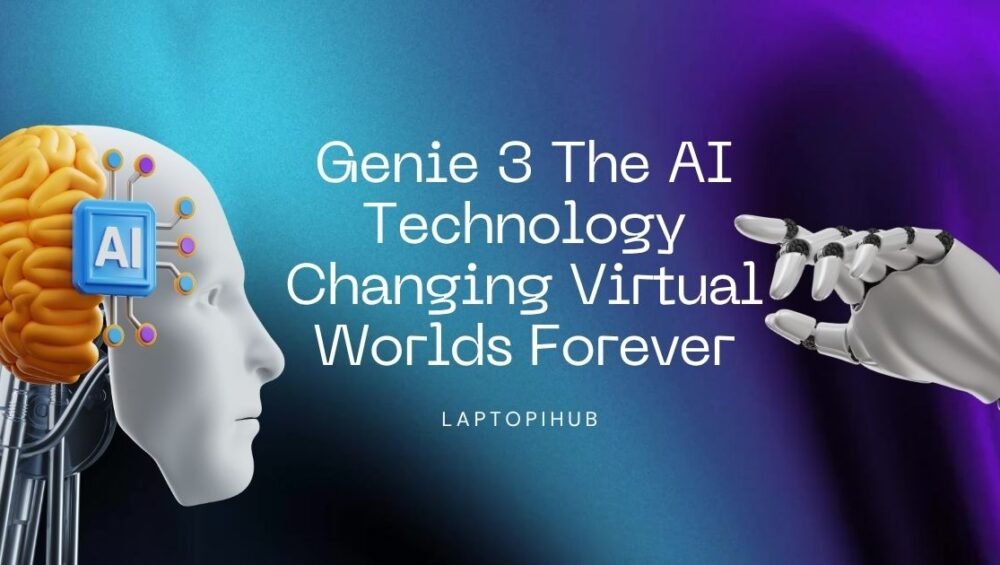Genie 3 by DeepMind creates real-time interactive 3D worlds from text — how it works, real uses, limits, and what creators should expect.
Introduction
Imagine typing a single sentence and instantly stepping into a living, responsive 3D world that follows your commands. You could change the weather, add a creature, or transform the landscape with just a few words. This is exactly what Genie 3 promises — DeepMind’s latest “world model” that generates real-time, interactive 3D environments directly from text prompts. Unlike simple AI video clips, Genie 3 creates persistent, explorable worlds that respond to your actions, making it a groundbreaking leap toward AI-driven virtual spaces.
What is Genie 3
Genie 3 is an advanced AI system designed to generate interactive, playable 3D worlds based solely on natural language input. This means you can describe a scene, and Genie 3 will not only create it but also keep it consistent over time. Characters remain where you place them, weather changes on demand, and objects behave logically within the scene. It’s a significant step forward from previous AI models, which often struggled to maintain scene continuity beyond a few seconds.
How Genie 3 Works
World Models Explained
At the heart of Genie 3 is the concept of a world model. This is essentially a learned system that predicts what should happen next in a scene. Instead of relying on strict rules coded by developers, Genie 3 has been trained on vast amounts of visual and spatial data to understand how worlds evolve naturally. The model uses these learned patterns to generate scenes that feel believable, dynamic, and alive.
Neural Rendering and Memory
One of Genie 3’s most important advancements is its ability to remember the state of a world over time. Traditional AI-generated videos quickly lose coherence, but Genie 3 uses a form of neural memory to keep track of object positions, lighting changes, and interactions. This memory isn’t stored in a database; it’s a learned continuity that allows a scene to remain stable for extended periods.
Prompt Handling and Statefulness
Genie 3 is built to respond dynamically to new prompts without restarting the scene. If you start with a sunny beach and later request a rainstorm, the world will shift seamlessly while preserving everything else you’ve built. This makes Genie 3 feel less like a static generator and more like a living environment you can manipulate in real time.

Key Capabilities
Real-Time Interactive Environments
Unlike previous AI tools that output short, fixed videos, Genie 3 offers real-time interactivity. Users can explore the generated world, move the camera, and interact with objects and characters. This transforms the experience from passive viewing into active engagement.
Persistence and Scene Memory
One of the most impressive features is scene persistence. Genie 3 can maintain a consistent environment for several minutes, making it ideal for storytelling, simulations, or rapid prototyping of game levels. This is a huge leap compared to earlier systems that could only keep a coherent scene for a few seconds.
Promptable World Events
With Genie 3, you can add or modify elements mid-session. You might start in a peaceful meadow, then summon a castle in the distance or fill the sky with fireworks. The system adapts instantly, integrating the new elements into the ongoing world without breaking immersion.
Visual Fidelity and Framerate
While Genie 3 currently runs at about 720p and 24 frames per second, the output is smooth enough for immersive exploration. The visuals may not yet match high-end game engines, but the trade-off for real-time generative creation is well worth it.
Limitations and Known Issues
Physics, Hallucinations, and Artifacts
As advanced as Genie 3 is, it’s not perfect. Sometimes objects may behave in unrealistic ways, like floating or clipping through surfaces. Characters may display odd proportions or movements, and visual artifacts can appear during long sessions. These are natural growing pains for a technology that is still in its early stages.
Scope and Agent Complexity Limits
Currently, Genie 3 excels at creating landscapes, stylized environments, and simple interactions. However, highly complex multi-character scenarios or fine object manipulations can still reveal its limitations. This makes it more of a creative tool for experimentation than a polished production system.

Safety, Ethics, and Responsible Use
Misinformation and Deepfake Risk
Any technology capable of generating realistic environments can be misused. There’s a risk of creating fabricated scenes that could spread misinformation or be used for unethical purposes. As a result, responsible usage policies and safeguards are essential.
Bias, Misuse, and Access Control
Because Genie 3 learns from large datasets, it can unintentionally replicate biases present in its training data. This is why developers must ensure that safety checks and filters are in place. For now, access to Genie 3 is limited to researchers and selected creators to study both its potential and its risks.
Practical Applications
Game Design and Indie Developers
For game developers, Genie 3 offers the ability to rapidly prototype levels without manual asset creation. Developers can simply describe a setting and see it instantly come to life, making iteration faster and more creative.
VR/AR and Immersive Media
In the VR and AR space, Genie 3 could revolutionize the way environments are created. Instead of painstakingly modeling every detail, creators could quickly build immersive worlds with minimal effort.
Robotics and Embodied Agent Research
Genie 3’s persistent, interactive worlds are ideal for training AI agents in simulated environments. This could accelerate research in robotics, where agents need to learn navigation, object handling, and decision-making.
Film, Previsualization, and Concept Art
Directors and artists can use Genie 3 to rapidly experiment with scene layouts, lighting conditions, and camera angles. This makes it an invaluable pre-production tool for visual storytelling.
Education and Simulation
From creating historical reenactments to simulating complex scenarios like emergency response training, Genie 3 opens new possibilities for interactive education.

How Genie 3 Compares to Game Engines and Other AI
While game engines like Unreal or Unity offer more precision and control, they require significant manual work. Genie 3 trades some of that precision for speed and creative flexibility, allowing you to generate playable concepts instantly. Compared to static AI video generators, Genie 3 stands out with its interactivity and scene persistence.
What Creators and Developers Need to Know
Genie 3 works best when prompts are clear and descriptive. The more detail you provide, the better the generated world will match your vision. However, you should treat outputs as prototypes rather than final products, combining them with traditional tools when moving toward production.
Early Tester Insights
Early testers have found Genie 3 to be a powerful brainstorming tool. Its ability to rapidly create and adjust worlds makes it perfect for exploring creative ideas. Still, testers caution that it’s important to document your prompts and settings, as the model’s outputs can vary with subtle changes in input.
The Road Ahead — Where Genie 3 Could Lead
Future versions of Genie could bring higher-resolution outputs, longer-lasting worlds, and even multiplayer experiences where multiple users interact in the same AI-generated space. Integration with existing game engines could bridge the gap between rapid generation and production-quality assets. However, these advancements will require careful consideration of ethical and safety concerns.
Conclusion
Genie 3 marks a significant step toward AI-powered interactive worlds. By combining real-time generation with persistent environments, it offers a glimpse into a future where creating virtual spaces could be as easy as typing a sentence. While the technology still has limitations, its potential for gaming, research, education, and creative industries is enormous. The challenge now is to develop it responsibly so that its benefits can be enjoyed without misuse.
FAQs
Q1 — What can I create with Genie 3 right now?
Currently, Genie 3 is ideal for building concept environments, stylized scenes, and interactive demos for testing ideas.
Q2 — Is Genie 3 available to the public?
Access is currently limited to researchers and select creators while the technology is still being refined.
Q3 — How is Genie 3 different from game engines like Unreal?
While Unreal requires manual asset creation, Genie 3 can instantly generate worlds from text prompts, though with less precision.
Q4 — Can Genie 3 handle realistic human interactions?
Not yet. It can generate characters, but complex social behavior and precise movement remain challenging.
Q5 — What’s the future of Genie 3?
Future versions could feature higher resolution, longer persistence, and integration with game engines for more advanced uses.






